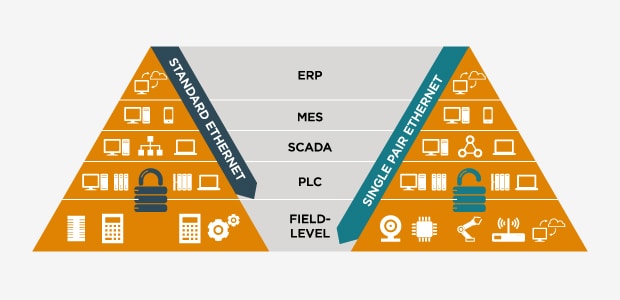
Trend Insight
A GAME-CHANGER FOR INDUSTRY 4.0 – NEW SPE STANDARD
Adoption of a hybrid Single Pair Ethernet standard moves the industry closer to making Smart Manufacturing a reality, finally bringing ethernet capabilities to the edge of the network.
In the near future, one-cable ethernet-based connectivity solutions can be deployed in smart factories to reach the next level of automation, which will unlock new gains in manufacturing productivity and efficiency. This technological leap forward is possible thanks to TE Connectivity’s efforts to establish a common standard for industrial Single Pair Ethernet (SPE) — a standard that finally makes it possible to bring ethernet to the edge of the industrial network.
Closing the Gap at the Field Device Level
While standard ethernet has been a mainstay for business enterprise and work center solutions, and industrial ethernet has brought high-speed communication capabilities to work stations and control devices within the manufacturing setting, there’s been a gap at the field device level. The sensors on the machines that have advanced so incredibly in recent years, were held back from communicating with the rest of the network by analog and fieldbus technologies that do not speak the same “language” as high-speed ethernet. Fortunately, with the newly announced industrial Single Pair Ethernet (SPE) standard, industrial communication will become more transparent, enabling virtually barrier-free connection from the cloud to the field devices connected at the edge.

Defining a Common Industrial SPE Standard
After much discussion and collaboration, in September 2021, connectivity providers and trade groups agreed to the IEC 63171-7 cable using the M12 connector as the industrial standard for SPE. The IEC 63171-7 (or “-7” for short) provides an interface for hybrid SPE and power transmission in one cable, with high-speed data transmission up to 1 Gbps/600 MHz and power up to 11 kW/16 A. This allows engineers to optimize machine-to-machine communication in their applications without loss of data, to decentralize computing power, and get data to the edge of the network in a more streamlined, transparent way.
Adopting the -7 as the industrial SPE standard has several additional advantages for manufacturers:
- It melds seamlessly with existing ethernet infrastructure
- It provides simple plug-and-play connectivity capabilities
- It uses a single cable and connector combo that is built to withstand harsh environments
- It uses separate pins for data and power contacts, increasing the power options
- It provides the reliability, durability, and security that are required in industrial settings
- Its one cable/one connector design reduces overall cost and allows it to fit smoothly into compact spaces - important for the ongoing trend toward miniaturization
Making SPE More Accessible
Aligning on the -7 standard is a key step in making the bold future of Industry 4.0 possible. This slim, lightweight yet powerful connectivity solution enables the industry to digitize at the field level and is a critical part of the industrial internet of things (IIoT) infrastructure.
To prepare for the move to smart manufacturing, businesses need to transition their traditional communication and bus system solutions to an ethernet-based infrastructure. However, without a SPE standard for the industrial market, manufacturers were understandably reluctant to take the leap. Fortunately, that barrier has been lifted with the announcement of the -7 industrial SPE standard.
Creating a universal standard clarifies and streamlines manufacturers’ connectivity choices so they can confidently invest in installing industrial SPE in their field devices (sensors, etc.). Aligning on the -7 standard also enables businesses to use a standardized interface, which improves planning security. It also allows businesses to gain efficiencies in real-time communication and transparency from the cloud to the field level thanks to the ethernet-based hybrid power/data solution. These two areas are key motivators for manufacturers to make the transition to SPE.
Preparing for the Smart Tech Trend in Manufacturing
Because the M12 connector defined for the hybrid concept is already in wide use throughout the industrial market, the -7 standard will be easier for manufacturers to adopt. It will provide businesses further flexibility to design the network that works for their specific manufacturing needs and gives engineers more leeway to configure software and data so they can create a barrier-free communication ecosystem from the sensor to the cloud, enabling seamless communication from machine-to-machine and machine-to-human. This is necessary for businesses to tap into machine learning, artificial intelligence, and other next-generation innovations that are revolutionizing the IIoT.
The hybrid configuration of the -7 standard also provides increased flexibility to distribute power across networks vs. the point-to-point connection that power-over-data-line ethernet requires. That means it is possible to distribute higher currents to several cascaded power devices.
Helping Businesses Optimize Manufacturing
After years of driving SPE innovation in the automotive industry, there is a lot of excitement within TE Connectivity to finally bring the technology’s powerful advantages to manufacturing. Industrial ethernet connectors and cables have their uses and benefits, but the opportunities inherent in a truly integrated system capable of real-time communication that the -7 industrial SPE standard brings about are staggering. The acceptance of this universal SPE standard will unlock technological advancements for the industrial market and help more businesses optimize their manufacturing.
At TE Connectivity, we deliver next-generation solutions that meet the diverse needs of customers who are looking to gain speed in driving IIoT forward and to help make smart manufacturing a success. TE Connectivity has a robust portfolio of SPE products to help customers meet their ambitious Industry 4.0 goals, the applications expertise to get them there and offices around the world to serve customers wherever they are.

Eric Leijtens, Strategic Business Development, TE Connectivity
Eric Leijtens, oversees the strategy for field-level connectivity within TE's Industrial business unit. Eric is also the Vice Chairman of the SPE Industrial Partner Network, a trade group dedicated to making SPE the standard in industrial automation.
Learn more




